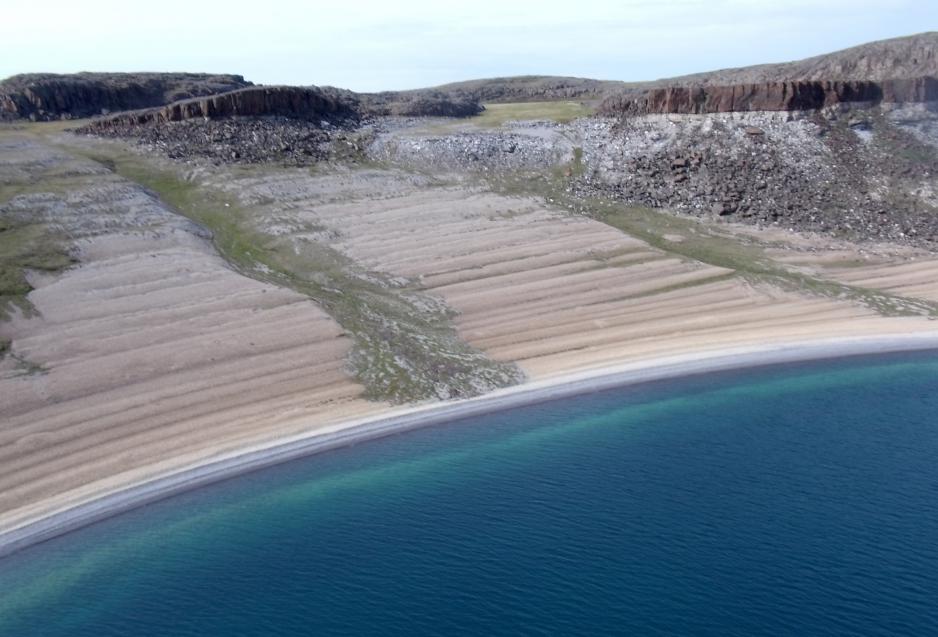Coastal Erosion and Thawing Permafrost: A Dangerous Duo

Coastal erosion has long thought to be caused by melting ice and higher waves. But there’s more heat to the story. A new study by Dr. Emile Guegan shows the thermal dynamics of thawing permafrost to be a major contributor to the Arctic’s eroding edges.
Global sea level rise is eating away at coastal communities across the globe, none more so than those located in the Arctic. By some estimates, the Arctic is eroding three to four times faster than more temperate regions of the world. Such a rapid pace of erosion does more than change the physical landscape. It endangers the wellbeing of communities and the local economies upon which they rely.
Over 200 villages affected
A 2009 US Government Accountability Office report estimated that over 200 villages in Alaska are affected by erosion and flooding, with 31 in imminent danger.
Four of these villages are already in the process of relocating, leaving behind their homes, ancestral lands, and buried loved ones. These Alaskan communities are suggestive of a wider vulnerability of Arctic villages across the region where schools, hospitals, and airports are built on the coast.
Beyond the wellbeing of local communities, shoreline erosion holds the potential to damage global transportation and energy networks. As the region prepares for an ice-free future, Arctic and non-Arctic companies are investing in coastal infrastructure to support trans-Arctic shipping and oil extraction. With the livelihood of communities and international ports being threatened simultaneously, there is an immediate need to address the causes of shoreline erosion in the circumpolar north. Despite this need, scientists have struggled to understand why the Arctic is eroding so quickly – until now.
Permafrost
Through a year-round time-lapse project, Dr. Emile Guegan and a research team based in NTNU have discovered a previously unknown case of coastal erosion in the Arctic. Waves are the most immediately recognizable culprit in coastal erosion. The battering of strong tides and storms on a coastal bluff can quickly corrode the soil and threaten its structural integrity. In the Arctic, the retreat of sea ice and resulting open water increases the potential for wave erosion. Many studies conducted over the summer have proven the dangers of less ice. But once winter arrives, research teams studying erosion retreat back to their labs and wait for spring. While logically easier to study in warmer weather, limiting research to the summer means that only half the situation is observed.
In order to study erosion year-round, Dr. Guegan used time-lapse cameras on Svalbard and buried dozens of thermistors, special measurement probes, on eroding cliffs. Similar instruments were set up in the Varandey area and Baydarskaya Bay in Siberia. Collectively, this technology enabled her team to make a year-round profile of the soil temperatures and how they relate to erosion. It was through this year-round research that Dr. Geugan discovered that snow cover and thawing permafrost are major reasons for rapid coastal erosion in the Arctic.
- Snow has a huge impact on the coast, says Geugan to Science Nordic.
With changing storm patterns and warmer air, winds blow snow from the tops of cliffs into large piles against coastal bluffs. These piles of snow act as an insulator, making it warmer underneath and effectively thawing the once stable frozen soil. As it thaws, the soil loses its strength and collapses and leaves the cliff more exposed to waves.
Thermal and Mechanical
Guegan’s study is the first to show that coastal erosions are due to both thermal and mechanical factors. Much work has been done to mitigate mechanical erosion from waves. Building seawalls, augmenting cliffs with sandbags, and putting fences to keep sand in place have been used successfully in many areas of the world. However, with this new understanding of thermal factors comes a new need to develop different coastal protection designs for the Arctic. Creating new designs to better protect the coastline from thawing permafrost will require a better understanding of frozen soil behavior, which, according to Guegan, “we know almost nothing about.”
Her team, partnered with the University Centre in Svalbard, SINTEF, Moscow State University, and Zubov State Oceanographic Institute in Russia, will build a better understanding through a series of reports. Their research will continue the rates, mechanisms, and modeling of permafrost coastline erosion. While future work will add more academic publications to a relatively sparse field, the uses of Guegan’s research goes beyond scholarship.
In 2006, an oil terminal on the Varandey coast had to be shut down because the coastline was crumbling away. The Varandey area’s airstrip and communities are still threatened by coastal erosion. Local officials have put in a fence near the airstrip to keep soil and sand in place to ameliorate the heavy waves. Knowing the dynamics of erosion in permafrost cliffs will not only help Varandey officials, but practitioners across the Arctic region to build designs to protect communities from both mechanical and thermal erosion in the years to come.
Throughout 2016 author Victoria Herrmann is traveling across America for a National Geographic funded book on climate change stories, America's Eroding Edges.
